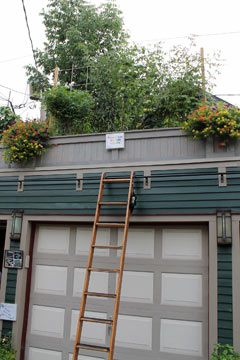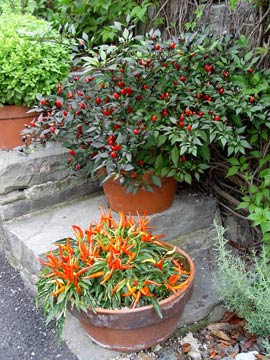 This Buffalo, NY gardener grows his vegetables on top of the garage roof, which he accesses via a sliding library ladder.
This Buffalo, NY gardener grows his vegetables on top of the garage roof, which he accesses via a sliding library ladder.
© George Weigel
No room in the yard to dig a vegetable garden? No matter. Most vegetables grow just as well in containers as in the ground—sometimes better. Decks, patios, driveways, balconies, window boxes and even rooftops are all candidates as veggie-growing sites. All you need is a half-day or more of sunlight and enough effort to keep your pots watered and fertilized.
In many ways, growing edibles in containers is easier than a conventional vegetable plot. There’s no tilling, hardly any weeding, and much less threat from animal attack. The potting mix that should be used in containers is also usually better for root growth than the compacted clay or rocky soil that plagues so many back-yard gardens. Even disease is less likely by virtue of fresh potting mix and clean, disinfected pots. To disinfect pots, scrub them with a solution of one part bleach to nine parts of water.
In exchange for those pluses, container gardeners have to pay closer attention to two issues:
- Pots dry out much quicker than in-ground gardens and generally need daily watering—sometimes more in very hot, windy weather.
- Because of the frequent watering, potted edibles also will need more fertilizer.
To deal with water-hungry potted plants, start by using big pots. The bigger the pots, the more soil they hold, and the slower they’ll dry out. 20- to 24-inch pots are a good size, and 14-inch ones are a reasonable minimum.
 A small pot garden of tomatoes is growing on top of concrete in this small back yard.
A small pot garden of tomatoes is growing on top of concrete in this small back yard.
© George Weigel
The type of pot also makes a difference. Plastic, foam, metal and heavy concrete pots lose less moisture than porous or thin terra-cotta, clay and ceramic pots. Moss-lined baskets lose moisture the fastest. If you’re using terra-cotta, clay, ceramic or moss baskets, line the insides with a sheet of plastic to slow evaporation loss. Don’t line the bottom, however. It’s important that water drain out the bottom because water-logged soil will kill plants almost as fast as bone-dry soil. That’s also why any pot you use should have adequate drainage holes in the bottom. If you don’t have enough, drill more. Place a piece of screen in the bottom to keep soil from rinsing out the holes.
Use only high-quality and light-weight potting mix in your containers, especially blends rich in perlite and coir (coconut fibers). These drain and “breathe” better than peat-based mixes. Don’t scrimp on cheap, heavy, poorly draining potting soils or worse yet, heavy and potentially diseased or bug-ridden soil from the garden. Some mixes come with polymer crystals that absorb moisture and release it back into the potting mix as it dries. Soil-wetting crystals can be added to any mix to improve watering efficiency and prevent plant losses due to dry soil – buying you some forgiveness in case you miss a day or two of watering. Check your pots daily for water. When the potting mix feels dry to the touch and is noticeably lighter in weight, it’s time to water. You’ll probably need to water daily. When you do, add enough until water drains out the bottom.
 An old washtub has become the new home for a planting of spinach.
An old washtub has become the new home for a planting of spinach.
>© George Weigel
All of that watering leaches nutrients from the mix quickly. Most vegetables are also heavy feeders, and most potting mixes are soilless, which means they don’t have a lot of nutrients to start with. The solution is to work a granular fertilizer into the potting mix before planting. Then scratch booster applications in the surface every 4 to 6 weeks throughout the growing season. You don’t have to be shy—it’s almost impossible to overdo it with fertilizer in container culture.
Compact crops work best in pots. These include lettuce, spinach, most herbs, broccoli, onions, leeks, carrots, beets and radishes. Peppers, eggplant, tomatoes, cucumbers and other larger crops also grow well in pots, although it’s best to choose small-sized or “bush” varieties. Staking also helps support larger plants in small spaces.
 Compact plants such as these hot peppers are good choices for container growing.
Compact plants such as these hot peppers are good choices for container growing.
© George Weigel
Because of the increased interest in container vegetable gardening, breeders have been churning out plenty of new compact varieties. In tomatoes, for example, try varieties such as ‘Terenzo,’ ‘Bush Early Girl,’ ‘Better Bush,’ ‘Pixie,’ ‘Patio Hybrid,’ ‘Window Box’ or ‘Red Robin.’
In peppers, try ‘Baby Belle,’ ‘Golden Baby Belle,’ ‘Carmen,’ ‘Gourmet’ or ‘Pompeii.’
In eggplants, try ‘Pot Black,’ ‘Hansel,’ ‘Gretel,’ ‘Bambino’ or ‘Fairy Tale,’ and in cucumbers, try ‘Salad Bush,’ ‘Spacemaster,’ ‘Hybrid Bush Crop’ or ‘Bush Champion.’
Add a few flowers to your pots for a planting that looks as good as it tastes.
Potted vegetables aren’t immune to bugs, but at least you shouldn’t have to worry about rabbits and groundhogs… unless yours have learned to fly.